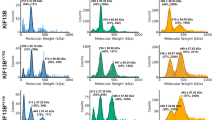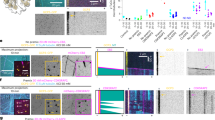Abstract
In all eukaryotes, CAP-Gly proteins control important cellular processes. The molecular mechanisms underlying the functions of CAP-Gly domains, however, are still poorly understood. Here we use the complex formed between the CAP-Gly domain of p150glued and the C-terminal zinc knuckle of CLIP170 as a model system to explore the structure-function relationship of CAP-Gly–mediated protein interactions. We demonstrate that the conserved GKNDG motif of CAP-Gly domains is responsible for targeting to the C-terminal EEY/F sequence motifs of CLIP170, EB proteins and microtubules. The CAP-Gly–EEY/F interaction is essential for the recruitment of the dynactin complex by CLIP170 and for activation of CLIP170. Our findings define the molecular basis of CAP-Gly domain function, including the tubulin detyrosination-tyrosination cycle. They further establish fundamental roles for the interaction between CAP-Gly proteins and C-terminal EEY/F sequence motifs in regulating complex and dynamic cellular processes.
This is a preview of subscription content, access via your institution
Access options
Subscribe to this journal
Receive 12 print issues and online access
$189.00 per year
only $15.75 per issue
Buy this article
- Purchase on Springer Link
- Instant access to full article PDF
Prices may be subject to local taxes which are calculated during checkout







Similar content being viewed by others
References
Riehemann, K. & Sorg, C. Sequence homologies between four cytoskeleton-associated proteins. Trends Biochem. Sci. 18, 82–83 (1993).
Gundersen, G.G. Evolutionary conservation of microtubule-capture mechanisms. Nat. Rev. Mol. Cell Biol. 3, 296–304 (2002).
Galjart, N. & Perez, F. A plus-end raft to control microtubule dynamics and function. Curr. Opin. Cell Biol. 15, 48–53 (2003).
Carvalho, P., Tirnauer, J.S. & Pellman, D. Surfing on microtubule ends. Trends Cell Biol. 13, 229–237 (2003).
Howard, J. & Hyman, A.A. Dynamics and mechanics of the microtubule plus end. Nature 422, 753–758 (2003).
Vaughan, K.T. Surfing, regulating and capturing: are all microtubule-tip-tracking proteins created equal? Trends Cell Biol. 14, 491–496 (2004).
Galjart, N. CLIPs and CLASPs and cellular dynamics. Nat. Rev. Mol. Cell Biol. 6, 487–498 (2005).
Akhmanova, A. & Hoogenraad, C.C. Microtubule plus-end-tracking proteins: mechanisms and functions. Curr. Opin. Cell Biol. 17, 47–54 (2005).
Miller, R.K., D'Silva, S., Moore, J.K. & Goodson, H.V. The CLIP-170 orthologue Bik1p and positioning the mitotic spindle in yeast. Curr. Top. Dev. Biol. 76, 49–87 (2006).
Badin-Larcon, A.C. et al. Suppression of nuclear oscillations in Saccharomyces cerevisiae expressing Glu tubulin. Proc. Natl. Acad. Sci. USA 101, 5577–5582 (2004).
Wen, Y. et al. EB1 and APC bind to mDia to stabilize microtubules downstream of Rho and promote cell migration. Nat. Cell Biol. 6, 820–830 (2004).
Erck, C. et al. A vital role of tubulin-tyrosine-ligase for neuronal organization. Proc. Natl. Acad. Sci. USA 102, 7853–7858 (2005).
Peris, L. et al. Tubulin tyrosination is a major factor affecting the recruitment of CAP-Gly proteins at microtubule plus ends. J. Cell Biol. 174, 839–849 (2006).
Li, S. et al. Crystal structure of the cytoskeleton-associated protein glycine-rich (CAP-Gly) domain. J. Biol. Chem. 277, 48596–48601 (2002).
Saito, K. et al. The CAP-Gly domain of CYLD associates with the proline-rich sequence in NEMO/IKKγ. Structure 12, 1719–1728 (2004).
Hayashi, I., Wilde, A., Mal, T.K. & Ikura, M. Structural basis for the activation of microtubule assembly by the EB1 and p150Glued complex. Mol. Cell 19, 449–460 (2005).
Honnappa, S. et al. Key interaction modes of dynamic +TIP networks. Mol. Cell 23, 663–671 (2006).
Goodson, H.V. et al. CLIP-170 interacts with dynactin complex and the APC-binding protein EB1 by different mechanisms. Cell Motil. Cytoskeleton 55, 156–173 (2003).
Lansbergen, G. et al. Conformational changes in CLIP-170 regulate its binding to microtubules and dynactin localization. J. Cell Biol. 166, 1003–1014 (2004).
Ligon, L.A., Shelly, S.S., Tokito, M.K. & Holzbaur, E.L. Microtubule binding proteins CLIP-170, EB1, and p150Glued form distinct plus-end complexes. FEBS Lett. 580, 1327–1332 (2006).
Sheeman, B. et al. Determinants of S. cerevisiae dynein localization and activation: implications for the mechanism of spindle positioning. Curr. Biol. 13, 364–372 (2003).
Watson, P. & Stephens, D.J. Microtubule plus-end loading of p150Glued is mediated by EB1 and CLIP-170 but is not required for intracellular membrane traffic in mammalian cells. J. Cell Sci. 119, 2758–2767 (2006).
Dujardin, D. et al. Evidence for a role of CLIP-170 in the establishment of metaphase chromosome alignment. J. Cell Biol. 141, 849–862 (1998).
Puls, I. et al. Mutant dynactin in motor neuron disease. Nat. Genet. 33, 455–456 (2003).
Levy, J.R. et al. A motor neuron disease-associated mutation in p150Glued perturbs dynactin function and induces protein aggregation. J. Cell Biol. 172, 733–745 (2006).
Krishna, S.S., Majumdar, I. & Grishin, N.V. Structural classification of zinc fingers: survey and summary. Nucleic Acids Res. 31, 532–550 (2003).
Honnappa, S., John, C.M., Kostrewa, D., Winkler, F.K. & Steinmetz, M.O. Structural insights into the EB1-APC interaction. EMBO J. 24, 261–269 (2005).
Askham, J.M., Vaughan, K.T., Goodson, H.V. & Morrison, E.E. Evidence that an interaction between EB1 and p150Glued is required for the formation and maintenance of a radial microtubule array anchored at the centrosome. Mol. Biol. Cell 13, 3627–3645 (2002).
Yan, X., Habedanck, R. & Nigg, E.A. A complex of two centrosomal proteins, CAP350 and FOP, cooperates with EB1 in microtubule anchoring. Mol. Biol. Cell 17, 634–644 (2006).
Parvari, R. et al. Mutation of TBCE causes hypoparathyroidism-retardation-dysmorphism and autosomal recessive Kenny-Caffey syndrome. Nat. Genet. 32, 448–452 (2002).
Folker, E.S., Baker, B.M. & Goodson, H.V. Interactions between CLIP-170, tubulin, and microtubules: implications for the mechanism of Clip-170 plus-end tracking behavior. Mol. Biol. Cell 16, 5373–5384 (2005).
Tirnauer, J.S., Grego, S., Salmon, E.D. & Mitchison, T.J. EB1-microtubule interactions in Xenopus egg extracts: role of EB1 in microtubule stabilization and mechanisms of targeting to microtubules. Mol. Biol. Cell 13, 3614–3626 (2002).
Vaughan, P.S., Miura, P., Henderson, M., Byrne, B. & Vaughan, K.T. A role for regulated binding of p150Glued to microtubule plus ends in organelle transport. J. Cell Biol. 158, 305–319 (2002).
Karki, S. & Holzbaur, E.L. Cytoplasmic dynein and dynactin in cell division and intracellular transport. Curr. Opin. Cell Biol. 11, 45–53 (1999).
Allan, V. Dynactin. Curr. Biol. 10, R432 (2000).
Busch, K.E., Hayles, J., Nurse, P. & Brunner, D. Tea2p kinesin is involved in spatial microtubule organization by transporting tip1p on microtubules. Dev. Cell 6, 831–843 (2004).
Busch, K.E. & Brunner, D. The microtubule plus end-tracking proteins mal3p and tip1p cooperate for cell-end targeting of interphase microtubules. Curr. Biol. 14, 548–559 (2004).
Perez, F., Diamantopoulos, G.S., Stalder, R. & Kreis, T.E. CLIP-170 highlights growing microtubule ends in vivo. Cell 96, 517–527 (1999).
Hayashi, I., Plevin, M.J. & Ikura, M. Activation of microtubule assembly by plus-end tracking proteins: regulatory interplays between EB1, CLIP-170 and p150Glued. Nat. Struct. Mol. Biol., advance online publication 9 September 2007 (doi:10.1038/nsmb1299).
Westermann, S. & Weber, K. Post-translational modifications regulate microtubule function. Nat. Rev. Mol. Cell Biol. 4, 938–947 (2003).
Scheel, J. et al. Purification and analysis of authentic CLIP-170 and recombinant fragments. J. Biol. Chem. 274, 25883–25891 (1999).
Komarova, Y. et al. EB1 and EB3 control CLIP dissociation from the ends of growing microtubules. Mol. Biol. Cell 16, 5334–5345 (2005).
Studier, F.W. Protein production by auto-induction in high density shaking cultures. Protein Expr. Purif. 41, 207–234 (2005).
Collaborative Computational Project, Number 4. The CCP4 suite: programs for protein crystallography. Acta Crystallogr. D Biol. Crystallogr. 50, 760–763 (1994).
Acknowledgements
We thank I. Hayashi for providing data before publication, F. Winkler and D. Kostrewa for support with the X-ray data processing, T. Güntert and Y. Bächtiger for technical assistance and C. Weirich for careful reading of the manuscript. X-ray data were collected at beamline X06SA of the Swiss Light Source. This work was supported by the Swiss National Science Foundation through grant 3100A0-109423 (to M.O.S.) and within the framework of the National Center of Competence in Research Structural Biology program.
Author information
Authors and Affiliations
Contributions
A.W. and S.H. designed and executed the cloning, protein purification and structure determination. R.J. designed and executed the cloning. O.O. and I.J. designed and executed the ITC experiments. D.F. purified the protein. A.A. designed and executed the fluorescence microscopy and FRET experiments and wrote the paper. M.O.S. designed the research, guided the project and wrote the paper.
Corresponding author
Supplementary information
Supplementary Text and Figures
Supplementary Table 1 (PDF 64 kb)
Rights and permissions
About this article
Cite this article
Weisbrich, A., Honnappa, S., Jaussi, R. et al. Structure-function relationship of CAP-Gly domains. Nat Struct Mol Biol 14, 959–967 (2007). https://doi.org/10.1038/nsmb1291
Received:
Accepted:
Published:
Issue Date:
DOI: https://doi.org/10.1038/nsmb1291
This article is cited by
-
Phase separation of EB1 guides microtubule plus-end dynamics
Nature Cell Biology (2023)
-
Control of motor landing and processivity by the CAP-Gly domain in the KIF13B tail
Nature Communications (2023)
-
Multivalency ensures persistence of a +TIP body at specialized microtubule ends
Nature Cell Biology (2023)
-
Tension of plus-end tracking protein Clip170 confers directionality and aggressiveness during breast cancer migration
Cell Death & Disease (2022)
-
HIV-1 capsid exploitation of the host microtubule cytoskeleton during early infection
Retrovirology (2021)



